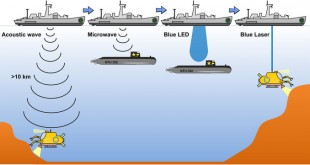Navies of various countries have announced making their warships and submarines propelled with an electric propulsion system. Instead of driving the ship’s propellers directly, diesel engines turn electric generators, which in turn power electric motors that drive the propellers. This arrangement enables diesels to be placed away from the shafts and propellers in sound-insulated compartments. Because the engines are not directly coupled to the shafts, their vibration does not pass along the shaft and thus does not get transmitted to the water as sound. An advantage of the system is that it eliminates the need for gears between the engines and the shaft. By doing so, removes a production bottleneck. The result is an almost silent propulsion system.
Several ship construction firms and electric motor manufacturers are thus striving to develop enabling technology, including high power density motors. The U.S. Navy plans to use the tech to power the upcoming Columbia-class ballistic missile submarines, set to go to sea in the mid 2020s. In Oct 2017, Engineers and scientists in China have started up the first Chinese ship with a permanent magnet motor system.
The permanent magnet motor consists of two main parts – a stator that carries a number of electrical coil windings turning the windings into electromagnets. Other is a rotor fitted with a number of very strong permanent magnets typically made of rare earth metals that have their own permanent electromagnetic field. A rotating magnetic field is created by the stator which interacts with the fields of the permanent magnets on the rotor, which generates force to drag the rotor around, providing the mechanical power.
Permanent magnet motors are by nature brushless motors and have several advantages of particular use to submarines. They are quieter, thus making the submarine equipped with them more difficult to detect. They are also more reliable and the parts last longer. They generate less electromagnetic interference, an important factor when you have dozens of electronic systems packed in a metallic tube. Finally, they are also smaller than competing motors, taking up less volume in the submarine.
According to Rolls-Royce, the permanent magnet tunnel thruster offers numerous advantages over traditional tunnel thrusters including reduction in noise and vibration, an increase in power output of around 25% from the same size propeller, and is removable underwater eliminating the need for dry docking.
The permanent magnet tunnel thruster design concept comprises a permanent magnet motor in a rim, which drives the propeller in the centre. Other benefits of permanent magnet technology include the freeing up of space directly above the thruster where traditional tunnel thruster motors are located, and a symmetrical design that gives equal thrust to port or starboard, Rolls-Royce said. It is available in 1,600mm and 2,000mm diameter.
Permanent magnet propulsion motor technology
A synchronous PM machine contains Neodymium-Iron-Boron (NdFeB) magnets, which are materials with a very high flux density. This makes them ideal for variable speed motors and generators throughout the entire speed range. The magnet field is created with almost zero rotor losses.
A PM machine gives high-efficiency performance over the entire operating range, significantly cutting back on fuel consumption. The PM machine is typically 2–4% more efficient at full load and 10% more efficient at part load when compared with induction machines. These efficiencies result from a lack of current losses in the rotor, the absence of an exciter, and reduced winding losses.PM propulsion motors and their inverters efficiently turn available energy into thrust, designed to deliver even higher efficiency in a much wider speed and torque range.
Lower Fuel Consumption
In a recent study of two 1250 kW diesel-electric propulsion trains, PM motors achieved an annual fuel savings of >3% with the same Z-drive thruster. PM motors also make it possible to use an L-drive thruster, which results in fuel savings by an extra >1%, along with length and weight savings thanks to the stacking ability.
Adjustable Speed Control
A frequency converter offers the accurate and adjustable speed control needed for dynamic positioning and demanding load cycles in offshore and special vessels. The high energy density of PM technology and resulting lower rotor inertia are beneficial when the ship needs high maneuverability and a DP class propulsion system. This results in optimum fuel efficiency and lower levels of exhaust.
Highly pulsating power demand also poses a serious threat to the lifetime of a vessel’s engine. The ability to deliver to a combination of short full-power bursts and longer low-power demands is extremely wearing.To handle highly fluctuating load cycles, guarantee longer engine life, cut back on fuel consumption and reach lower exhaust values, adjustable speed control is ideal. This avoids the low or no-load running of generators, which minimizes engine heat stress, reduces fuel consumption and eliminates undesired start/stop engine cycles.
Fewer Failures, Less Maintenance
In direct propulsion systems, no gearbox or accompanying slip rings and brushes are needed, as with other synchronous machines. Therefore, the PM propulsion line machine experiences fewer failures and requires significantly less maintenance.PM solutions are compact, with lower weight and volume than conventional drive trains. They offer good flexibility and a smaller footprint for all types of configurations, especially when space is a critical factor. Additionally, PM solutions comply with low environmental footprint requirements.
By using a PM generator as part of a genset, significant weight savings can be achieved, and the total length of the genset can be reduced. On the propulsion side, using a PM machine as a propulsion motor combined with an inverter can lead to weight savings and switchboard length reductions.
Frequency Converters
The Switch frequency converters are optimized to work with PM machines for the best overall system efficiency. The electricity produced is of better quality with low flicker, reduced electrical noise emission and THD <1.5%. Additionally, PM drive trains have always demonstrated superior grid connection behavior, even in distributed environments. The frequency converter features a rugged IP54-class cabinet, which is a higher class to withstand the harsh sea environments. It can be easily accessed for installation and maintenance.
Siemens unveils new FLEX PM modular submarine propulsion motors
Siemens premiered its new generation of modular scalable permanent magnet submarine propulsion motors at the Underwater Defence Technology (UDT) 2019 exhibition in Stockholm. To provide solutions across a wider range of applications, Siemens is evolving its Permasyn permanent magnet compact submarine propulsion motor.
The current Permasyn offering is available with ratings of approximately 2 MW and 4 MW, and has to date been used on Thyssenkrupp Marine Systems’ Type 212A and Type 214 submarine designs, with the first motor delivered for installation in 2000.
The new motors are planned in three baseline frame sizes, with the diameter determining three power ranges. The specific power rating within one range is then fine-tuned with the length of the stator and rotor. The ultimate size and weight are also driven by the associated inverters, which are integrated in the motor itself. According to Siemens, the specifications for this drive concept have been completed and initial development work has commenced.
With the new FLEX PM development, Siemens is also expecting improvements in reducing acoustic and magnetic signatures. The move to a modular system is meant to create more common parts across several motors, to simplify the supply chain and reduce the risk of obsolescence while making it easier to develop new motor variants.
General Atomics to develop permanent-magnet propulsion motor for LDUUV
The Navy has launched Large Displacement Unmanned Underwater Vehicle (LDUUV) program that will design, fabricate, and field a new class of large displacement highly autonomous, Unmanned Undersea Vehicles (UUVs) to provide increased endurance, long range, and payload hosting.
The LDUUV System must have sufficient range and endurance to provide the fleet with a capability to autonomously complete missions in the current mission set and expected future missions under development. The vehicle can already operate for up to 30 days, but the goals are much loftier. “I’m talking power generation, fuel and battery technology, that can approach months and years of underwater domain activity,” Adm Winter said.
The US Office of Naval Research has awarded General Atomics Electromagnetic Systems a contract to design and deliver an advanced permanent-magnet propulsion motor to be used on the US Navy’s large displacement unmanned undersea vehicles (LDUUVs). Norwegian Cruise Line has selected a Rolls-Royce permanent magnet tunnel thruster to upgrade the propulsion package onboard cruise vessel Norwegian Epic.
Jay McFadyen, Senior Vice President – Marine Services, Americas, Rolls-Royce, said, “This highly innovative and cutting edge permanent magnet technology is suitable for a range of applications in both merchant and offshore vessels, where exceptionally low noise levels, high power output and rapid response to power demand will benefit operators, crew and, very importantly, passengers alike.
The US Office of Naval Research (ONR) has awarded General Atomics Electromagnetic Systems (GA-EMS ) a contract to design and deliver an advanced permanent-magnet propulsion motor intended for use in the US Navy’s (USN’s) Large Displacement Unmanned Undersea Vehicle (LDUUV) programme.“After completing a review of our motor’s capabilities and the applicability for undersea operations, we are very excited to take the next step to design and deliver a second-generation propulsion motor to ONR for further evaluation and eventual on-vehicle testing,” Rolf Ziesing, vice president of Programs at GA-EMS, said.
LDUUV is a new class of large-displacement unmanned undersea vehicles that will provide increased endurance, range and payload capabilities. The navy is designing the vehicle for intelligence, surveillance and mine countermeasure missions, and is based on a modular, open architecture that will allow the Navy to develop new mission sets for the craft.According to the navy, the vehicle will be capable of being stowed, launched and recovered by multiple-host platforms, including littoral combat ships, Virginia-class submarines and Ohio-class guided-missile submarines.
References and Resources also include:
 International Defense Security & Technology Your trusted Source for News, Research and Analysis
International Defense Security & Technology Your trusted Source for News, Research and Analysis


